The Camargue National Park and National Nature Reserve, southern France
Designations
Part of the Camargue National Park, National Nature Reserve, RAMSAR Site, Special Protected Area (SPA) protected under European Wild Birds Directive, European Heritage Site, UNESCO Biosphere
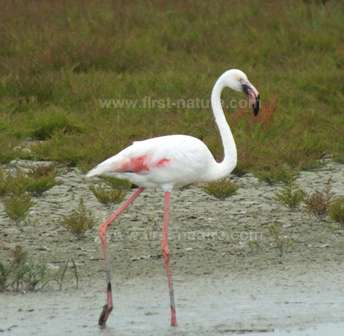
The Flamingo. The Camargue National Park is one of the most important breeding sites in the world for these iconic birds.
The Camargue National Park - Parc National de Camargue is famous for its white horses, miniature black bulls and flamingos, but has so much more to fascinate anyone who has an interest in the natural world.
The Park is situated on the Mediterranean coast of south eastern France and incorporates the Camargue National Nature Reserve which has a visitor centre at La Capeliere. The centre is open seven days a week from March to the end of September. From the first of October it is open every day in the week except on Tuesdays. If you are unlucky enough to turn up on the day the centre is closed, as we did non our first visit, don't despair, the nature trail at La Capeliere is open and there are excellent information boards throughout the walk to tell you about the different habitats and wildlife that lives there.
Although communication may be difficult if you are not a French speaker, the lasting impression of the staff at Camargue National Park is that they care very much that you have a good experience and get as much from your visit as possible. Please read the list of precautions below that you should take before venturing out into the nature reserve.
A Brief History
The reserve we see today is the result of years of protection and intensive management to preserve the plants, animals, birds and insects that depend on the many habitats found in the Camargue National Park for their survival. The area has been managed by the Societe National de la Nature (SNPN) since 1927, but only became a National Nature Reserve in 1975.
Nature conservation has not always been of importnace of those living in the Camargue, however, and the SNPN has had to mediate between combatants in some tough battles between the salt producing industry which wanted to turn the whole area over to saltpans on the one hand, and on the other, the farming industry who wanted to desalinate much more of the sea water entering the area so that they could graze animals and grow crops.
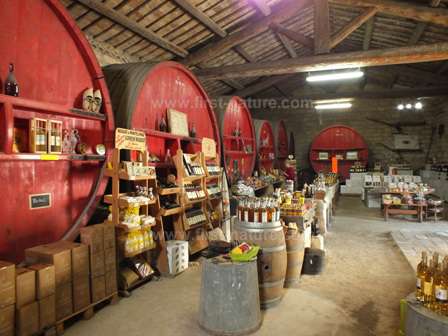
One of the many centres in the Camargue where the special products of the area can be tasted and bought.
For over 40 years the SNPN, lead by the efforts of a remarkable botanist, G. Tallon, fought these battles alone, but eventually the French Government bought the land prior to designation as a National Nature Reserve. Today the reserve is funded by a combination of organisations, and the efforts of the conservationists were further recognised in 1986 when the area received additional protection by being designated as a RAMSAR site - a wetland of international importance.
Today the area welcomes thousands of naturalists every year. They provide a massive bonus to the local economy by eating and staying in the area and visiting many of the outlets to buy some of the outstanding natural produce of the region, including the famous Vins du Sable (wines of the sand), the Camargue rice and locally produced Sel du Mer (sea salt).
Access and Facilities
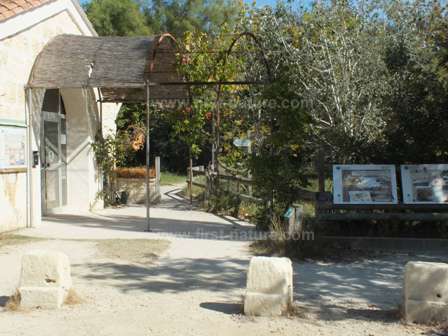
The main Visitor Centre at La Capiliere
Visitor Centres
The main Visitor Centre for the Camargue National Park is situated at La Capeliere. It is manned throughout the year and has an excellent 1.5 kilometre nature trail (part of which has access for the disabled) through a number of habitats. The walk has good information boards although not all of them have English language elements.
La Capeliere has an information desk and a small shop where you can pick up leaflets and buy literature about the Reserve and the wildlife. There is an exhibition about the Camargue National Park and its wildlife. The centre has limited parking, a public toilet and there are picnic tables in the garden.
There are two other centres within the Reserve that are not manned all the time. From the Salon de Badon you can access a 4.5 kilometre trail which has three bird hides, while the Phare de La Gacholle Lighthouse centre has a display and access to a 20 kilometre walking/cycling trail along the active sand dune system on the fringe of the Mediterranean Sea. It is a good place to see some of the unique plants and creatures that make their homes in this inhospitable and highly mobile landscape. Access to the sand dunes is restricted. More about sand dunes...
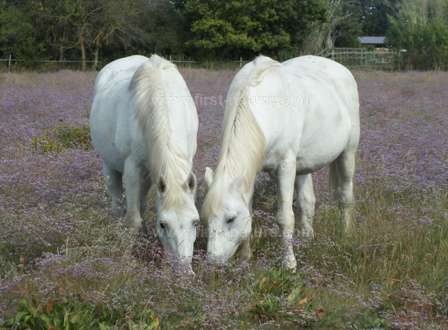
The famous white horses of the Camargue graze in a pasture full of Sea Lavender in late summer
General Information about the National Nature Reserve
The unique landscape of the Camargue is created by Europe's largest river delta. The Rhone River rises in the Swiss Alps and flows from the Rhone glacier at Valais creating a massive cleft which separates the Alps from the Massif Central. At Arles in southeastern France the river divides into two arms, the Grand Rhone and the Petit Rhone. It is the emergence of these two arms of the Rhone into the Mediterranean Sea that creates the massive delta known as the Rhone Fan.
The Camargue National Park was created in 1972 and covers 85,000 hectares of land. The National Nature Reserve within the National Park consists of an area in excess of 13,000 hectares of which over 95% is protected from human use. Despite this, there are plenty of opportunities for walkers and cyclists to see much of the special habitats and many of the birds for which the area is most famous. The main road out to La Capeliere, the D36B, has observation points and informal parking on the side of the road from which it is possible to see the wading birds at quite close quarters.
A Few Precautions
Although the temperature in the Camargue seldom drops below freezing it is famously windy, the most nortorious of the winds being the mistral which blows from the north west. The area is also known for its ferocious Mediterranean storms which regularly feature thunder and lightening and torrential rain. Protective clothing and glasses are essential if venturing out in windy conditions especially in areas where the sand is mobile.
From April through to the end of November the area seethes with mosquitos so make sure you have clothes that cover your skin, wear a hat and take a good insect repellent with you.
Shops are non-existent in the Nature Reserve and so you should take plenty of water with you - in summer the temperatures regularly reach 30 degrees C.
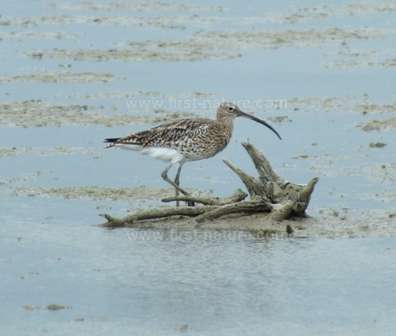
A Curlew wades in shallow water close to the Visitor Centre at La Capeliere
Flora and Fauna of the Camargue
Birds in the Camargue National Nature Reserve
Early morning is by far the best time to observe the numerous species of birds that visit or are resident in the Camargue. It is hardly surprising that the Camargue is so famous for its wading birds - so many of the iconic species can been seen here: Flamingos, curlews, Pied Avocets, Black-winged Stilts, Grey Herons, Purple Herons, Little Egrets, Avocets, Redshanks and Kentish Plovers, among many. Gulls and Terns include Herring Gull, Black-headed Gull and Sandwich Tern, Common Terns and Little Terns.
Other very rare birds can be seen (or heard) here, too, including the Night Heron, Bittern, Little Bittern and Squacco Heron. In recent years the Great White Heron has arrived in the Carmargue National Nature Reserve just as the Cattle Egret did before it.
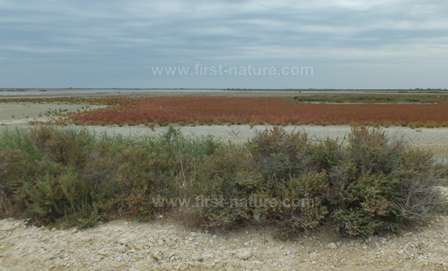
The Sansouire is a strange Camargue habitat which is parched and salt-laden in summer and submerged by sea water in the winter.
At the right time of year numerous ducks arrive in the Camargue. They are mainly passing through but a few are resident: Mallard, Shelduck, Red-crested Pochard and Gadwall. Migratory species include the Tufted Duck, Shoveller, Pintail, Wigeon and Teal.
Waders and ducks are not the only birding highlights for visitors to the Camargue: the wooded areas are home to many other species.. They include Nightingales, Great Tits, Jackdaws, Coots, Moorhens, Yellow Wagtails, Spectacled Warblers, Dartford Warblers, Tawny Owls, Great Spotted Woodpeckers, Lesser Spotted Woodpeckers, Green Woodpeckers, Wrens, Black Kites and Sparrow Hawks. Two other special birds that appear in the Camargue are the beautifully coloured Bee Eater and the European Roller.
The marshes and reedbeds are one of the most noticeable habitats in the nature reserve and are easy to see from the road. Today the delicate balance of nature to be found there requires intensive management and water must be pumped in to maintain the water levels which are essential to support the wildlife that depends on the marshland. Before man intervened and constructed dykes, the marsh water levels were maintained by natural flooding from the river and rainfall. Look out for the Reed Warblers and Bearded Tits that nest and raise their young in the extensive reedbeds, herons also feed there and the areas are patrolled by Marsh Harriers in search of unwitting prey.
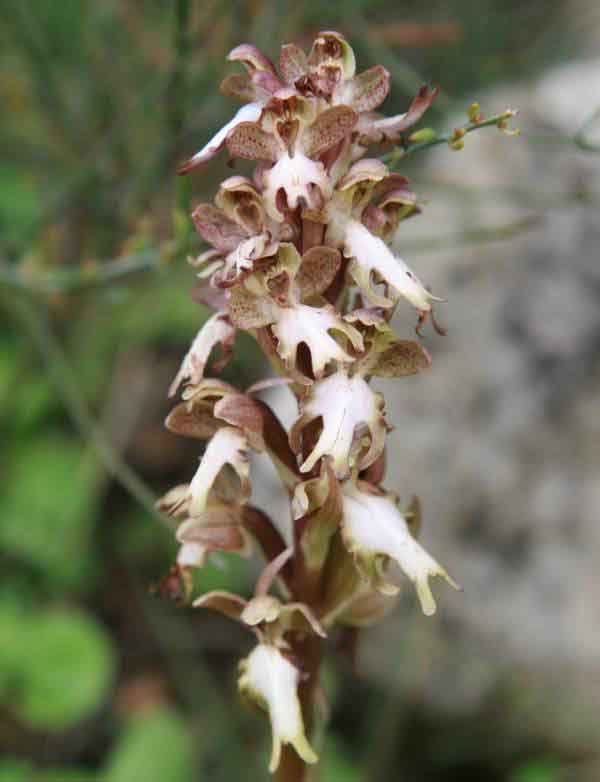
The Giant Orchid Himantoglossum robertianum
The sansouire is one of the most curious habitats in the reserve. This harsh place, which is completely flooded with sea water in the winter, becomes a parched salt-laden desert in the summer. but despite that, provides one of the most sought-after refuges in Europe during bird migration: tens of thousands of ducks rest there once the area becomes flooded in autumn, and the shallow water is ideal feeding ground for waders.
The most obvious plant in this inhospitable place is Glasswort - in the spring it forms a bright green carpet which turns red in late summer and autumn. It is also the most mosquito-laden part of the reserve and any disturbance of the short, shrubby plants as you walk through will stimulate clouds of them into action.
Flamingos in the Camargue
The Rhone delta in the Camargue is the only nesting site in France for Flamingos. Of the 50 - 60,000 Flamingos that are found in the south of France in spring and summer only around 5 - 6.000 overwinter there. The vast majority migrate south to Africa and then make the return journey north in February and March the following year. They are extremely vulnerable: only half of those that arrive in the Camargue will breed and, even then, each pair only lays one egg. After a spectacular mating ritual which takes place in March and April the pairs build a cylindrical mud nest upon which the single egg is deposited. The icubation of the egg, which takes about a month, is shared by the parents, but once the baby hatches, it is moved to a 'creche' where the juveniles are managed en masse until the end of July when they are able to fly. The birds are not fully mature until they are 5 - 6 years old.
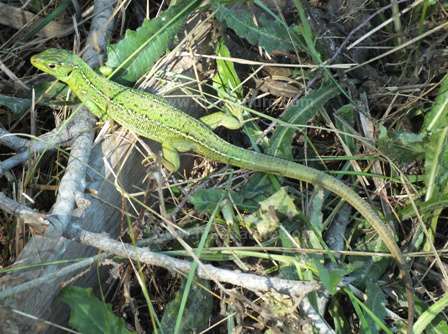
Lizards bask on the warm paths of the reserves and scuttle into the plants on the edges as soon as you approach
Mammals and other animals
Apart from the white horses and the black miniature bulls that the area is famous for, the inhospitable habitats of the Camargue support a surprising number of mammals. The horses, once wild, are now tamed, fenced in and mainly used to provide horse-riding for the tourists. The bulls are seldom seen and are more evident in the food shops where they put in a pothumous appearance in the form of delicious sausages!
Mammals are very seldom seen during the day, and early mornings and late evenings are the best time to spot them. The Camargue is home to Wild Boar, Fox, Beaver, Coypu, Badger, Polecat, Rabbit, Shrew and Woodmouse. In the evenings numerous Pipistrelle Bats fly over the marshy and wet habitats searching for the insects which are not in short supply in the area.
Adders are present in the reserve as are lizards. In the wet wooded areas live Tree Frogs along with other species of frogs and toads - even if you cannot see them you will certainly hear them as you walk through the reserve. The other most noticeable sound is the almost continual calling of the Cetti's Warblers - depite their strident song they are virtually impossible to spot amongst the dense foliage of the trees.
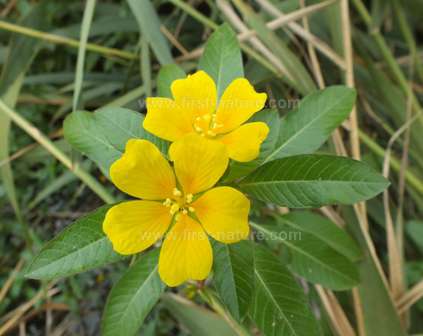
The Uruguayan Water Primrose Ludwigia uruguayensis is an alien plant that has colonised the freshwater dykes in parts of the Camargue National Nature Reserve
Flora
Plants within the nature reserve are limited to those that can tolerate the extreme conditions - salt-laden soil, air and water along with the ferocious winds that blow throughout the year. Two out of three days are windy. The sand dune system is moist during the winter and early spring but becomes parched in the summer. Plants to look out for are Sea Stock, Sand Stock, Sea Holly, Sea Spurge and Sea Wormwood. Later in the season the beautiful Sea Daffodil defies the weather odds by flowering in July.
The Sansouire is dominated by glassworts, Sea Blight and Sea Purslane. Further inland the grasslands, which have freshwater, are richer in plants and, in late summer, Sea Lavender smothers the fields creating a mauve haze above the ground through which the grazing white horses appear to wade. Despite the harsh conditions the chalk content of the sandy soil is suitable for quite a number of wild orchids including Marsh Helleborine Epipactis palustris, Giant Orchid, Himantoglossum robertianum, Lizard Orchid Himantoglossum hircinum, Pyramidal Orchid Anacamptis pyramidalis, Fragrant Bug Orchid Orchis coriophora sp. fragrans, Lax-flowered Orchid, Orchis laxiflora, Bee Orchid Ophrys apifera, Yellow Bee Orchid Ophrys lutea, Summer Lady's-tresses Spiranthes aestevalis, Autumn Lady's-tresses Spiranthes spiralis and Long-lipped Tongue Orchid/Ploughshare Orchid Serapias vomeracea. See table below for a photographic table of the orchid species found in the Camargue National Park.
The freshwater dykes harbour an attractive alien plant, the Uruguayan Water Primrose Ludwigia uruguayensis. If left to its own devices the plant, which grows stems several metres long, can completely choke waterways even to the extent that it prevents access by boats.
Forest in the Camargue
The days when the Camargue was covered with wild forest are long gone as a result of the manmade drainage systems which have been imposed on the area. A few wooded areas, along the sides of the freshwater dykes and rivers still exist and protect the creatures that would otherwise be driven to extinction in the National Park and Nature Reserve.
The dominant tree species are Ash, Willow and White Poplar. Woodpeckers, Rollers and Great Tits build their nests in holes bored in the tree trunks, while other species such as the Nightingale live in the more open woodland edges. The understory of bramble and Dogwood supports the numerous tree frogs.
The importance of the woodlands for birds, insects and amphibians is now increasingly recognised and efforts are being made to replace trees and reinstate areas of woodland throughout the Park and Nature Reserve.
Find and identify wild orchids in the Camargue National Park and Nature Reserve
 |
Anacamptis fragrans - Fragrant Bug Orchid - L'Orchis odorant
As its name suggests, this orchid is 'fragrant' and supposedly smells much more pleasant than the very similar Anacamptis coriphora which is said to smell of bugs - hence it's English name of Bug Orchid. Whether or not these two very similar orchids are the same or different species is still the subject of much debate. The plant flowers in May and the dune slacks are a good place to look. |
 |
Anacamptis laxiflora - Lax-flowered Orchid - L'orchis a fleurs laches
Orchis laxiflora grows to around 60cm in height and flowers from May to the beginning of July. It tolerates both alkaline and slightly acidic soil conditions and is nearly always found in wet, marshy areas of grassland. his plant is rare in the delta but can be found in damp meadows in the surrounding area. It flowers from the end of April and well into May. |
 |
Anacamptis pyramidalis - Pyramidal Orchid - L'orchis pyramidal
A common orchid in the Camargue but very beautiful nonetheless. It is a lovely deep pink in colour and the flowerhead is distinctly pyramidal in shape when the flowers first start to open. Later they become much more egg-shaped which often fools people into thinking that they have found something other than the Pyramidal Orchid. It flowers from mid May to mid June. |
 |
Anacamptis pyramidalis var. alba - Pyramidal Orchid - white variant
As above but occasionally a pure white form will appear among the pink flowers. |
 |
Cephalanthera damasonium - White Helleborine - La Cephalanthere a grandes fleurs
This species is a rare find for the Camargue National Park and is easily confused with its close relative, Sword-leaved Helleborine which is more common there. It flowers from May and into June. Look for it on the edge of woodlands close to the town of Arles. |
 |
Cephalanthera longifolia - Sword-leaved Helleborine - La Cephalanthere a longues fueilles
This orchid is a woodland species and can be found in the open woodland rides in late April and early May. The best place to look is in the remnants of the forests in the northern part of the delta close to Arles. |
 |
Cephalanthera rubra - Red Helleborine - La Cephalanthere rouge
Easily distinguished by its lovely rose-coloured flowers, the Red Helleborine occurs in the pine woodlands of the Camargue. It flowers in May and June and the area around La Grande-Motte is a good place to look. |
 |
Epipactis helleborine - Broad-leaved Helleborine - Epipactis a larges feuilles
Broad-leaved Helleborine is still common in most European countries where it can be found in woodland particularly on the edge of paths where it benefits from partial sunlight. It is a rare find in the Camargue National Park and flowers from the end of May and well into June. It can easily be confused with Epipactis bugacensis ssp. rhodanensis - L'Epipactis du Rhone which is considered to be the more common species in the area. Good places to look are in the sand dunes and dune slacks and in the pine woodlands close to La Grande-Motte. |
 |
Epipactis microphylla - Green-flowered Helleborine - Epipactis a petites feuilles
This is a difficult orchid to spot because of its overall green colour, insignificant flowers and tiny leaves. It flowers from mid May to mid June and is occasionally found in the dune slacks in the Carmargue National Park. |
 |
Himantoglossum hircinum - Lizard Orchid
The Lizard Orchid is a wonderful and easy orchid to find in the Camargue where it competes with the Giant Orchid for space. The amazing flowers, which really do resemble lizards, vary from greenish-cream to pink. It flowers from mid May to the beginning of June and can grow up to a metre in height. |
 |
Himantoglossum robertianum - Giant Orchid - Le Barlie de Robert
This amazing orchid is one of the first to flower each year, often appearing in January in the southern part of France. It grows to well over a metre in height. The plants in the Camargue grow in the dunes and dune slacks and are clearly able to tolerate the salty soils, wind and rain. It flowers between January and the end of March. |
 |
Limodorum abortivum - Violet Limodore - Le Limodore a feuilles avortees
This strange orchid grows in open woodland and on roadside verges close to trees. At first it resembles a bright purple asaparagus spear and may or may not fully open its flowers - hence its scientific name of abortivum. Look out for this species in woodland with pine trees. The plants fail to appear altogther in some years only to return at a later date. Although this orchid has been recorded from the Camargue it has not been seen there in recent years. |
 |
Neottia ovata - Common Twayblade - Listere a deux feuilles
Common by name but not common in the Camargue, Neottia ovata is a chalk-loving orchid which flowers freely in grasslands. Look out for it from May onwards. It can be very hard to spot because it blends in so well with the surrounding vegetation. |
 |
Ophrys lutea - Yellow Bee Orchid - L'Ophrys jaune
This delightful orchid appears in small groups in the Camargue in the sand dune slacks where it is protected from the worst of the salt laden winds and rain. It is a chalk-loving plant and the crushed shells in the sandy soil of the Carmague provide its ideal habitat. It flowers in April. |
 |
Ophrys apifera - Bee Orchid - L'Ophrys abeille
A favourite orchid for many people, the Bee Orchid is found in unimproved meadows and pastures in the Camargue National Park. It flowers from mid May onwards and sometimes appears with white petals and sepals rather than the more usual pink ones. |
 |
Ophrys insectifera - Fly Orchid - L' Ophrys mouche
This rare orchid has not been recorded in the Camargue since 1990 but is a fascinating find. It is one of the ophrys species which excite so much interest in how orchid flowers evolve in order to survive. The plants with flowers which most resemble the pollinating insect they seek to attract are the ones which go on to successfully reproduce. It flowers in May and was last seen in the area around La Grande-Motte. |
 |
Ophrys araneola
This orchid appears very early in the year and is rather difficult to spot, and even more difficult to identify accurately. In France, Ophrys incubacea (L'Ophrys noiratre) and Ophrys araneola are regarded as two separate species whereas some authorities regard them as one and the same or, where differentiation is possible, as sub species of the same orchid. The situation is further complicated by the presence of Ophrys exaltata ssp. marzuola (L'Ophrys de mars) which is reported to flower in the Camargue between mid February and the end of March. |
 |
Ophrys scolopax - Woodcock Orchid - L'Ophrys becasse
Although relatively common in parts of southern France, the Woodcock Orchid is rare in the Camargue making only an occasional appearance. It flowers throughout April. |
 |
Orchis anthropophora - Man Orchid - Orchis homme pendu
The Man Orchid which is relatively common in other parts of France has only once been recorded from the Camargue National Park in 1954. |
 |
Orchis purpurea - Lady Orchid - Orchis pourpre
Probably one of the most beautiful orchids, and one that can grow to a metre in height. Found in the Camargue in the past but not seen in recent years, the Lady Orchid flowers throughout April. |
 |
Orchis simia - Monkey Orchid - Orchis singe
Southern France is one of the best places to see the Monkey Orchid but it is an occasional find in the Camargue National Park. It flowers from mid April to mid May. |
 |
Serapias lingua - Tongue Orchid - Le Serapias langue
This is the type species of the tongue orchids and is possibly the most attractive. It has true pink flowers and is easily distinguished from the other tongue orchid species not just by its colour but also by the dark red spot deep in the 'throat' of the flower. It is a rare find in the Camargue. It flowers from the end of April until the end of May. |
 |
Serapias vomeracea - Long-lipped Tongue Orchid/Ploughshare Orchid - Le Serapias en soc
Distinguishable from Serapias lingua (see above) by its much more orange colour and the long hairy lip of the flower which gives it its somewhat unattractive scientific name. It flowers from mid-May well into June. |
 |
Spiranthes spiralis - Autumn Lady's-tresses
This autumn-flowering species is in steep decline throughout its distribution range due to loss of habitat and the use of agricultural chemicals. In the Camargue National Park it flowers in dry, sandy meadows and can be seen from the end of September to the end of October.
Summer Lady's-tresses Spiranthes aestivalis (Le Spiranthe d'ete) also occur in the Camargue and flower much earlier - in the middle of June. It is a rare orchid throughout its range and is the subject of international protection. Great care should be taken not to disturb the plants, or those of any wildflowers, and they should never be picked or dug up. |
Top of page.